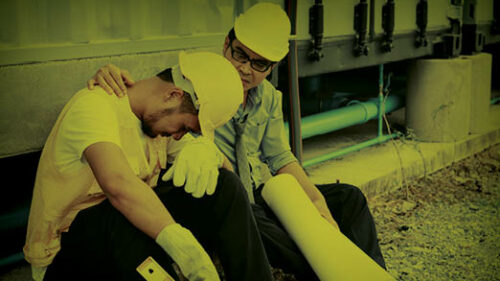A robust construction industry is the foundation of a healthy economy. Construction and industrial tradespersons help build America. From the hands of trades workers come the necessary infrastructure and buildings where we conduct our lives in every way. The construction workforce helps build the economic prosperity and social progress we all enjoy.
Unfortunately, the construction workforce is paying a steep price for their efforts. There is mounting evidence the construction workforce is a high-risk industry for various physical and behavioral health conditions. The construction and industrial trades have high incidences of:
| Physical Health Conditions | Behavioral Health Conditions |
| Fatigue | Social isolation and loneliness |
| Obesity | Stress and anxiety |
| High-blood pressure | Depression |
| Tobacco use | Propensity for risk-taking |
| Cardiovascular disease | Heavy/binge drinking |
| Musculoskeletal disorders | Substance misuse |
| Chronic pain | Suicide |
There isn’t enough space in a blog to provide the statistics to support each listed condition. Instead, this blog is to create awareness and understanding that the construction workforce is considered high risk for both physical and behavioral health.
Why Are the Risks so High in the Construction Workforce?
There are many fundamental industry factors that influence the risk factors, including the low social image of the industry and how other careers are more esteemed.
Additionally, workers are paid on an hourly basis, so if work is canceled by weather, schedule, or sequencing delays, there is no pay. This creates access barriers to adequate medical healthcare and behavioral health services.
The ebb and flows of economic cycles, combined with end-of-project furloughs and seasonal layoffs, impact the financial wellbeing of workers. Construction is a pressure-packed industry with increasing demands to meet rising performance standards in schedule, budget, productivity, quality, and safety. This stress undermines the wellbeing of the workforce.
Are There Other Risk Factors?
Yes! There are four other interrelated risk factors that further impact the physical and mental health of construction workforce:
- Workforce culture, including the stoic “tough guy and gal” work ethic where feelings aren’t talked about and the job must go on. Stigma about mental wellbeing runs high as is typical of male-dominated industries.
- Company factors, including the nature of the work of specific trades, location of work, amount of work, schedule and sequence of work, and the amount of overtime.
- Job stressors, including the long hours, and physically and mentally demanding working conditions in sometimes harsh environmental conditions.
- Worker lifestyle choices, including whether a worker is receptive to seeking medical care and behavioral health services; individual choices made with respect to nutrition, exercise, alcohol, and substance use; and adoption of stress management and self-care practices.
The net effect of these risk factors is that construction has the second highest rate of suicide, which is over three times higher than the rate for the general population in the United States. Because of the size of its workforce, construction has the highest number of suicides among all occupations. The reality is that more construction workers die by suicide annually than die in all occupational fatalities in safety incidents.
What Is CSDZ’s Commitment to the Construction Industry?
CSDZ is committed to helping contractors and labor organizations understand the cultural and social determinants of physical and behavioral health wellbeing. The first step toward organizational improvement is increasing awareness of the risk factors.
Over time, we’ll be sharing data, tools, and resources with contractors to help assess their relative degree of workforce risk and its impact on the physical and mental wellbeing of their workers.
Ultimately, working together with contractors and labor organizations, we aim to help achieve stronger wellbeing, both physical and mental, among construction trades workers. And, we’re on a mission to “make it OK to not be OK”! As a result, we’ll continue this series next week, for the second in our “The Invisible Construction Crisis” 4-part series every Wednesday through June 24.
In the meantime (or at any time, for that matter), don’t hesitate to reach out to CSDZ or the Construction Industry Alliance for Suicide Prevention (CIASP). We’d like to talk with you about this topic and begin moving the construction industry in the direction of physical AND mental wellbeing.







